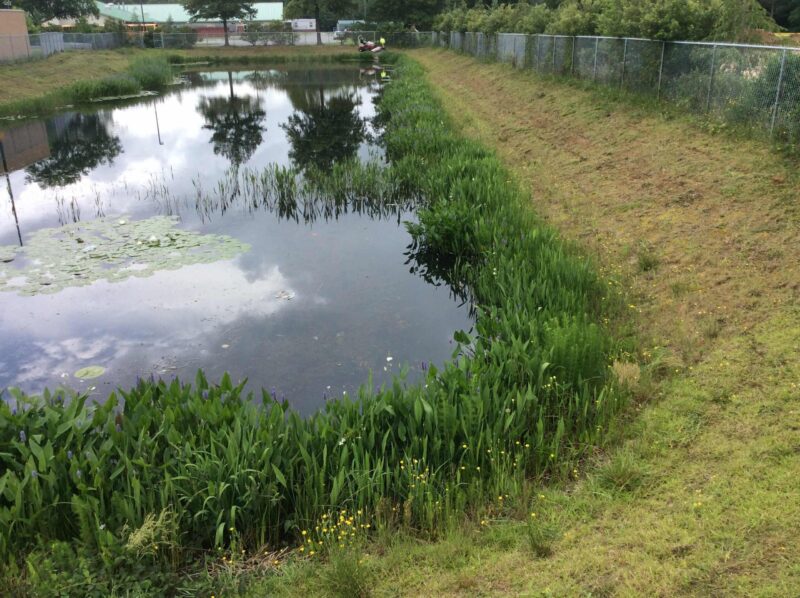The Importance of Retention Pond Shorelines
By Jason Abert, VP Program Development & Partnerships
Retention ponds installed on a property are an engineered stormwater control measure. While the small body of water on the edge of a property may seem insignificant, a non-functional retention pond can be a massive issue and potentially a liability for a property owner. Each retention pond is designed for the site it belongs on; variables include size, depth, plants and riser structure.
Retention ponds have various functions, most commonly they store runoff and remove pollutants. Retention ponds are just one part of a larger stormwater system on your property. Other structures like catch basins, bio swales and underground infrastructure can convey stormwater towards the retention pond where it will be treated and stored until it flows further downstream.
As rain falls, it flows to catch basins and through underground pipes to the retention pond. Here runoff can be stored for a designed duration of time while pollutants settle to the bottom and the treated stormwater continues through the riser structure downstream.
Each part of the retention pond design works together to achieve these goals. Retention ponds are built with sloped sides to allow for runoff to naturally enter the area. The degree of the slope depends on local regulations, which account for erosion and safety measures, and also the topography of the property.
Erosion is a large issue with improperly managed stormwater. Over time the edge, or buffer zone, along a stormwater pond can begin to erode and fall into the water. Runoff can amplify this issue as fast-moving stormwater loosens and disrupts soil on the embankment. If pond levels hold above design elevations for longer than their intended drawdown rate, the slopes can become additionally destabilized. Stormwater ponds are intended to have vegetation, especially along the water’s edge. The vegetation is chosen specifically for the site with maintenance, climate and native species in mind. The vegetation along the waterline is generally denser with deep root systems that serve multiple purposes. Many retention ponds are designed with aquatic benches, or littoral shelves, where native species that thrive in a few inches of water are selected. These plants allow for nutrient uptake, act as a buffer for debris and trash, discourage nuisance birds like geese and keep soil in place. If this bordering vegetation is lost, excess sediment can enter the pond, causing it to fail. This becomes a cycle as additional sediment enters the pond, the capacity is reduced, causing the water level to rise which can destabilize the slopes faster.
An uneven shoreline can be unsightly but may also be detrimental to the health of your stormwater system. Without an established littoral shelf or safety shelf, additional sediment entering the pond changes the depth of the pond and may inhibit the naturally occurring groundwater recharge.
A littoral shelf with established vegetation also protects the edge of the pond from erosion due to changing water levels common with season changes. This vegetation also collects trash and debris, preventing it from entering the pond and potentially continuing downstream. For more information about grasses and plants common in the Southeast, read our blog: Plants and Your Stormwater Control Measures.
There are a variety of techniques for protecting and repairing retention pond shorelines, AQUALIS will evaluate your property and choose the most appropriate response for the condition of your pond. Utilizing plants creates a “living shoreline” as opposed to structural choices like riprap or other methods which offer no water quality benefits. Call today to receive a FREE consultation.
